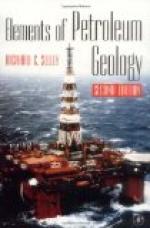THE INTRUSIVE ROCKS
The igneous rocks are divided into two general classes,—the volcanic or eruptive rocks, which have been outpoured in open air or on the floor of the sea, and the intrusive rocks, which have been intruded within the rocks of the crust and have solidified below the surface. The two classes are alike in chemical composition and may be divided into acidic and basic groups. In texture the intrusive rocks differ from the volcanic rocks because of the different conditions under which they have solidified. They cooled far more slowly beneath the cover of the rocks into which they were pressed than is permitted to lava flows in open air. Their constituent minerals had ample opportunity to sort themselves and crystallize from the fluid mixture, and none of that mixture was left to congeal as a glassy paste.
They consolidated also under pressure. They are never scoriaceous, for the steam with which they were charged was not allowed to expand and distend them with steam blebs. In the rocks of the larger intrusive masses one may see with a powerful microscope exceedingly minute cavities, to be counted by many millions to the cubic inch, in which the gaseous water which the mass contained was held imprisoned under the immense pressure of the overlying rocks.
Naturally these characteristics are best developed in the intrusives which cooled most slowly, i.e. in the deepest-seated and largest masses; while in those which cooled more rapidly, as in dikes and sheets, we find gradations approaching the texture of surface flows.
Varieties of the intrusive rocks. We will now describe a few of the varieties of rocks of deep-seated intrusions. All are even grained, consisting of a mass of crystalline grains formed during one continuous stage of solidification, and no porphyritic crystals appear as in lavas.
Granite, as we have learned already, is composed of three minerals,—quartz, feldspar, and mica. According to the color of the feldspar the rock may be red, or pink, or gray. Hornblende—a black or dark green mineral, an iron-magnesian silicate, about as hard as feldspar—is sometimes found as a fourth constituent, and the rock is then known as HORNBLENDIC granite. Granite is an acidic rock corresponding to rhyolite in chemical composition. We may believe that the same molten mass which supplies this acidic lava in surface flows solidifies as granite deep below ground in the volcanic reservoir.




